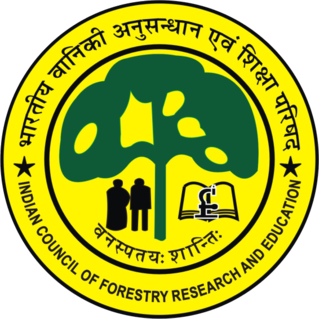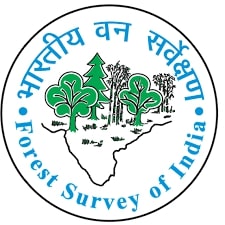Project Tiger is a wildlife conservation movement initiated in India to protect the endangered tiger. The project was initiated in 1973 by the Ministry of Environment, Forest and Climate Change of the Government of India. As of March 2024, there are 55 protected areas that have been designated as tiger reserves under the project. As of 2023, there were 3,682 wild tigers in India, which is almost 75% of the world's wild tiger population.

West Champaran is an administrative district in the state of Bihar in India, located just 60 km (37 mi) west of Birgunj. It is the largest district in Bihar with an area of 5,228 km2(2,019sq mi). It is a part of Tirhut Division. The district headquarters are located in Bettiah. The district is known for its open border with Nepal. One of the major location in West Champaran is Kumar Bagh for SAIL Special Processing Unit and Bhitiharwa where Mahatma Gandhi started Satyagrah Aandolan.
The Indian Forest Service (IFS) is the premier forest service of India. It was constituted in the year 1966 under the All India Services Act, 1951.

There are four categories of protected areas in India, constituted under the Wildlife Protection Act, 1972. Tiger reserves consist of areas under national parks and wildlife sanctuaries. There are 53 tiger reserves in India. As of January 2023, the protected areas of India cover 173,629.52 square kilometres (67,038.73 sq mi), roughly 5.28% of the total geographical area of the country.

The Bandhavgarh Fort is situated in Bandhavgarh in Umaria district of Madhya Pradesh, India. It is located on the Bandhavgarh hill, rising 811 meters above sea level at the centre of the Bandhavgarh National Park. It is surrounded by many smaller hills separated by gently sloping valleys. These valleys end in small, swampy meadows, locally known as 'bohera'.

The Indian Council of Forestry Research and Education (ICFRE) is an autonomous organisation or governmental agency under the MoEFCC, Government of India. Headquartered in Dehradun, its functions are to conduct forestry research; transfer the technologies developed to the states of India and other user agencies; and to impart forestry education. The council has 9 research institutes and 4 advanced centres to cater to the research needs of different bio-geographical regions. These are located at Dehradun, Shimla, Ranchi, Jorhat, Jabalpur, Jodhpur, Bengaluru, Coimbatore, Prayagraj, Chhindwara, Aizawl, Hyderabad and Agartala.

The Ministry of Environment, Forest and Climate Change (MoEFCC) is an Indian government ministry. The ministry portfolio is currently held by Bhupender Yadav, Union Minister of Environment, Forest and Climate Change.
Environment policies of the Government of India includes legislations related to environment.

India is one of the most biodiverse regions and is home to a large variety of wildlife. It is one of the 17 megadiverse countries and includes three of the world's 36 biodiversity hotspots – the Western Ghats, the Eastern Himalayas, and the Indo-Burma hotspot.
Kaziranga National Park is an Indian national park and an UNESCO World Heritage Site situated in the Golaghat and Nagaon district of Assam, India. It is a tourist destination and conservation area particularly notable as a refuge for the endangered Indian one-horned rhinoceros, hosting the largest population of wild Indian one-horned Rhinoceros in the world. The park contains significant stock of three other large herbivores — the Asian elephant, the Asiatic water buffalo and the eastern subspecies of the swamp deer. Kaziranga also has the highest density of tiger in the world and is declared a Tiger Reserve in 2006. Kaziranga is recognized as an Important Bird Area by Birdlife International for conservation of avifaunal species.

The National Tiger Conservation Authority (NTCA) was established in India in December 2005, following a recommendation of the Tiger Task Force. The Prime Minister of India established it to reorganise the management of Project Tiger and many Tiger Reserves in India.

Forest Survey of India (FSI), founded in June 1981 and headquartered at Dehradun in Uttarakhand, is the Government of India Ministry of Environment, Forest and Climate Change organization which conducts forest surveys, studies and researches to periodically monitor the changing situations of land and forest resources and present the data for national planning, conservation and sustainable management of environmental protection as well as for the implementation of social forestry projects.

The Katarniaghat Wildlife Sanctuary is a protected area in the Upper Gangetic plain, near Bahraich city in Bahraich district of Uttar Pradesh, India and covers an area of 400.6 km2 (154.7 sq mi) in the Terai of the Bahraich district. In 1987, it was brought under the purview of the Project Tiger, and together with the Kishanpur Wildlife Sanctuary and the Dudhwa National Park it forms the Dudhwa Tiger Reserve. It was established in 1975.

The Dudhwa Tiger Reserve is a protected area in Uttar Pradesh that stretches mainly across the Lakhimpur Kheri and Bahraich districts and comprises the Dudhwa National Park, Kishanpur Wildlife Sanctuary and Katarniaghat Wildlife Sanctuary. It covers an area of 1,284.3 km2 (495.9 sq mi). Three large forested areas are extant within the reserve, although most of the surrounding landscape is agricultural. It shares the north-eastern boundary with Nepal, which is defined to a large extent by the Mohana River. It ranges in altitude from 110 to 185 m, and several streams flow through the reserve from the northwest across the alluvial plain that encompasses the reserve.
The tiger reserves in India were set up as a part of Project Tiger initiated in 1973 and are administered by the National Tiger Conservation Authority of Government of India. As of March 2024, there are 55 protected areas that have been designated as tiger reserves. As of 2023, there were 3,682 wild tigers in India, which is almost 75% of the world's wild tiger population.

Conservation in India can be traced to the time of Ashoka, tracing to the Ashoka Pillar Edicts as one of the earliest conservation efforts in the world. Conservation generally refers to the act of carefully and efficiently using natural resources. Conservation efforts begun in India before 5 AD, as efforts are made to have a forest administration. The Ministry of Environment, Forest and Climate Change is the ministry responsible for implementation of environmental and forestry program in India, which include the management of national parks, conservation of flora and fauna of India, and pollution controls.
Shahgarh Landscape or Shahgarh Bulge Landscape is located in Jaiselmer District in Indian state of Rajasthan. This area is protected area for reintroduction of cheetah. The nearest city to this area is Jaiselmer. This area fences along the Indo - Pak border. This area is about 4000 km2 and has about 80 human settlements each having about 5 - 10 houses. Chinkara will be the primary prey for cheetah as the prey diversity is less in this region. Cheetah have been declared extinct in India in 1952.
Hemendra Singh Panwar is an Indian conservationist and civil servant, known for his efforts in the fields of wildlife and conservation. He was the first director of the Wildlife Institute of India and was the director of Project Tiger. The Government of India honoured him, in 2013, with Padma Bhushan, the third-highest civilian award, for his services to the environment and conservation.











